Rocklight from the TechnoNICOL company: features of the use of products

In recent years, the market for thermal insulation materials has been growing steadily. The leader in this field was the domestic brand "TechnoNICOL". But even the assortment of just one brand is sometimes difficult to understand. Let's get acquainted with one of the most popular products of the brand - the material "Rocklight".
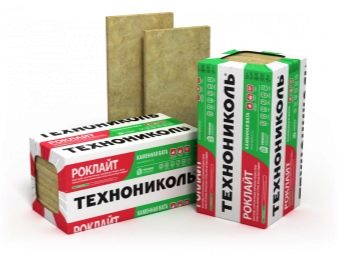

What it is?
Rocklight mineral wool from the TechnoNICOL company consists of synthetic fibers and thin crumbs of stone and clay. Due to its light weight, excellent evaporation and low hygroscopicity, this material cannot be overstated. On sale you can find it in the form of rolls and plates of different sizes and thicknesses - from 50 to 100 mm.
Heat is retained thanks to the multilayer structure, with interlayers. Unlike polystyrene, small rodents do not nest in rock wool. It can be noted that cotton wool quickly collects dust and does not withstand moisture, so water removal must be thought out more carefully.


The insulation has excellent thermal insulation. The material is made from natural compositions - fiberglass and quartz sand. It does not pose a danger to people and the environment, retains heat, absorbs noise and does not accumulate insects and rodents due to its inorganic origin. Mineral wool has a lifespan of about 50 years with no signs of decay, blooming or decay.

The safest and most famous type is basalt - it is a natural material, a stone that is turned into fine fibers at a factory. This insulation doesn't actually burn up to 1000 ° C.
Among the famous brands of basalt wool is Rocklight, which guarantees:
- excellent heat and sound insulation;
- lack of combustion;
- ease of installation.

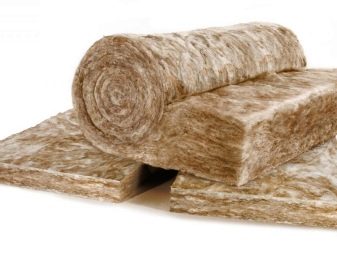
In addition, the price is pleasantly surprising, as is the high quality. Fire safety at a height. "Rocklight" is durable, vapor-permeable properties remain throughout the entire service life. There is never any fungus in mineral wool, the walls "breathe", which is important for insulating the attic.
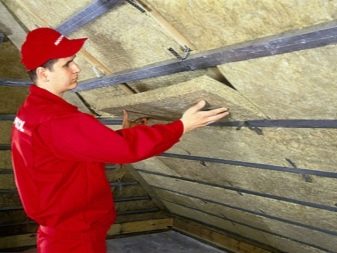
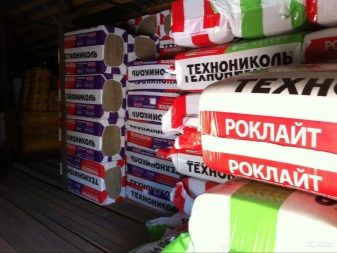
Mineral wool is made in the form of slabs or rolls. The material is quite soft, so it is not placed under the roof or filled from the inside. This material is made in various forms:
- rugs;
- lightweight, soft, semi-strong and durable plates;
- cylinders;
- in the form of loose wool.


According to GOST, mineral wool can be:
- glass;
- basalt;
- slag.


The composition may include binder resins. An insulating material is also mentioned, based on other minerals (not only basalt), which can include a variety of fibers and quartz shavings. The temperature limits for such heaters are 400-700 C.
Cotton wool has a thermal conductivity of 0.035–0.04 W / m. It is necessary to make good insulation, since this material has a water-absorbing property. When working with loose material, it is best to use a respirator.

Glass wool can be harmful in contact with skin and eyes, therefore it is necessary to work in special protective clothing, which is thrown away after use. When closed, the material is not hazardous.
There is also slag wool, but now it is almost never used. This material is cheap, but with low thermal insulation properties compared to others, it is not chemically neutral, so the presence of water can lead to corrosion of steel structures.
The general advantages of mineral insulation are that they are cheaper than most polymers, have good thermal insulation properties, and no water absorption.

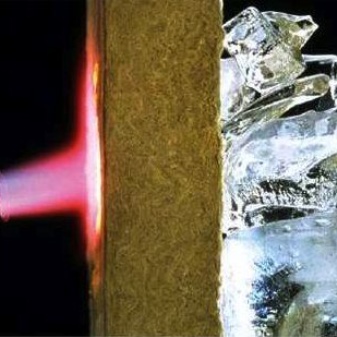
In terms of safety, some fear that mineral fibers are carcinogenic. Cancer Research Institute, has proven no harmful effects. That is, you can use the material without fear. The resins in the formulation are also safe in the working environment.

Specifications
The main factors in the selection of heaters are the coefficient of thermal conductivity, moisture resistance, fire resistance and environmental friendliness. Thermal conductivity refers to the ability of a material to transfer heat. The lower, the better the material retains it. The fire resistance of the material should be maximized.
Environmental friendliness means that it does not emit harmful substances and does not cause an allergic reaction. Stone wool, including basalt insulation, is one of the best insulation materials from this perspective. All types can be divided into plate and bulk material. All this is mineral wool, but presented in a different form.


The material should not be combustible, absorb moisture, because then it loses its ability to maintain heat. It is desirable that the plates or insulating sheets are large.
The fewer seams, the less heat will be lost. Therefore, do not use pieces or leftovers of material.
Density
The thickness of the layer depends on the climatic conditions: the colder, the thicker it should be. It is advisable to choose heat insulators with high density and low weight, such as Master. Heavy insulation adds stress to the rafters. The material should not change shape with sudden changes in temperature, for example, in heat or cold.
The compressibility of the plates does not exceed 30%, the moisture content in the mass corresponds to 0.5%. The material may contain organic substances, but their volume is not higher than 2.5%. The thickness usually changes in 10 mm increments, with a minimum of 50 mm and a maximum of 100 mm.


Dimensions (edit)
Thermal insulation with mineral or basalt wool is carried out in several stages:
- cleaning the surface from debris and pollution;
- installation of guide profiles that are tied at a height of 60 cm;
- use of fixing plates with dowels;
- reinforcement of the plate with special glue.

Roof insulation starts with planning and preparing:
- installation of windows;
- connection;
- internal insulation of the roof structure.


The following actions are performed if it is necessary to eliminate roof defects:
- a layer of waterproofing is created; when using conventional membrane materials, ventilation is required;
- laying material insulation in the space between the rafters;
- waterproofing can be stapled.
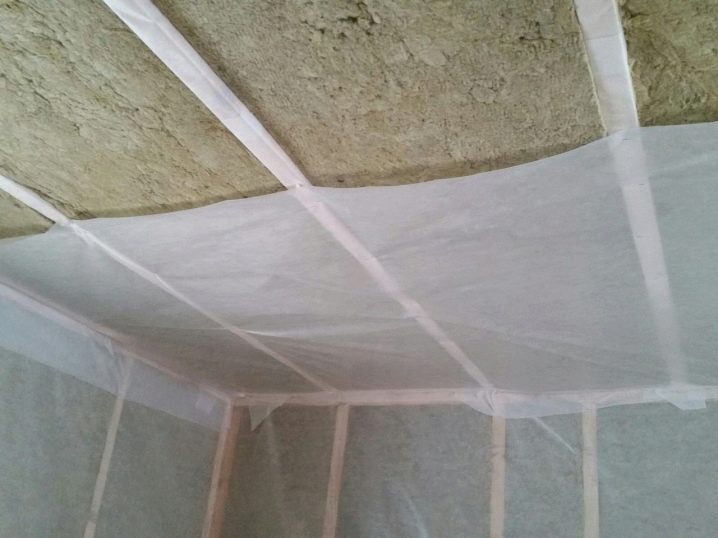
When insulating in blocks of mineral wool, place them in such a way that the length of the block is greater than the distance between the slings from 2 to 3 cm. The most demanded sizes of insulation: 1200 x 600 x 50, 1200 x 600 x 100 mm.
Subtleties of application
Not all thermal insulation materials are universal. Due to its high environmental sustainability, Rocklight should be used in soundproof rooms. Compared with expanded polystyrene, the advantages of the material in question are as follows:
- Resistant to open fire and high temperatures.
- Mineral wool can withstand high temperatures, unlike elongated polystyrene.
- The service life of TechnoNICOL basalt wool is about 50 years, extruded polystyrene sheets are destroyed in just 15–20 years.
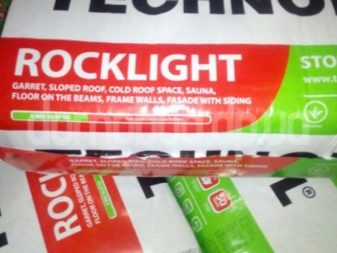

Easy installation, low cost, long service life and excellent technical performance and thermal insulation have made the products popular. This material is recommended for floor insulation in houses and apartments on the ground floor, mansard covering, roofing, for insulation of building facades under siding. The amount of material in each case is individual, based on the area of the coated surface.
Recommendations
When buying mineral wool, pay attention to the integrity of the package. The insulation of the package must be completely sealed, partially compressed, without scratches or torn film. Only in this way there will be no moisture in the insulation before installation. If there are defects, through holes and slots in the material that absorbs water and water vapor, the insulation becomes ineffective and changes geometry.
Rocklight insulation is placed between the steering rods. After installation, it is necessary to protect the mineral wool with a vapor-tight membrane from atmospheric moisture. Further on top of the vapor barrier are wooden blocks 20–30 mm thick.


The space between the vapor barrier film and the facade is necessary so that moisture can be freely removed from the surface of the film. It is important to observe this rule when installing mineral wool, because the material loses its properties when wet.
For thermal insulation of vertical structures, it is necessary to build a frame. When installing Rocklight slabs, make sure there are no holes. To exclude cold bridges, the insulation is placed in two layers so that the second one overlaps the joints on the first layer.
Above the layer of thermal insulation, the damping of the rolling water spreads with an overlap between the rolls of at least 150 mm. The vapor barrier is attached by a small body to the roof rails for condensate drainage. When installing a water seal, you should know on which side to correctly install the vapor barrier on the insulation.


When consumers buy Rocklight, they are especially interested in compressive strength as well as vapor permeability. The first parameter is equal to the limit of 30 kPa, and the other is 0.3 mg / (m × h, Pa).
Basalt insulation "Rocklight" allows you to save on installation. Any homeowner will be able to complete the installation work on their own. The material can be glued or screwed on, filling the joints with construction foam, pre-treating the surface with a primer as an alternative solution.

If it is a sloping roof, it is important to leave a ventilation gap between the insulation and the structure itself. For this "Rocklight" is mounted directly on the frame, which is reinforced from the inside at a distance of 30 centimeters between the slats. Installation work is quick and easy, as the plates are easily installed in the right place.
Reviews
Thermal insulation "Rocklight" from "TechnoNICOL" in everyday life is often referred to as mineral wool. This is partly true. The material is made from mountain basalt rocks. The mats are processed according to a special technology, which results in very tight and long-lasting thermal insulation with minimal thermal conductivity. This is also evidenced by its properties. It is designed for sound and heat insulation of premises.

50mm thick product is usually packed in 5.76 sq. m - 8 plates each. The insulation is characterized by stability in shape and volume. The material is resistant to very high temperatures and demonstrates ease of handling and installation. The opinions of people who have already looked at this material agree that it has a better performance compared to its counterparts. Consumers note among the advantages an affordable price, excellent thermal insulation properties, good vapor permeability.
There are also some caveats. It is worth working only with personal protection. Dust gets under clothing and into the respiratory tract. TechnoNICOL's Rocklight reviews reiterate complaints about material heterogeneity. In addition, the plates are sometimes heterogeneous in structure. In addition to different weights, there can be sheets of different thicknesses in the package. When the material gets wet, it loses some properties, has poor contact with gypsum mixtures.

To learn how to make TechnoNIKOL stone wool, see the video below.













It keeps its shape and volume very well. Great article! My husband and I were specifically looking for reviews on this insulation and found detailed information on this site.
The comment was sent successfully.